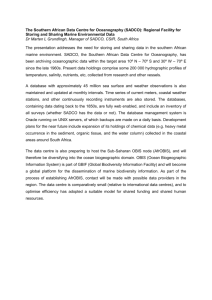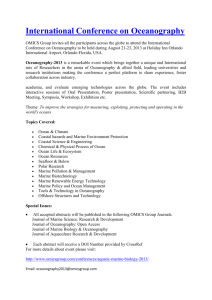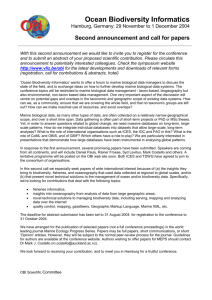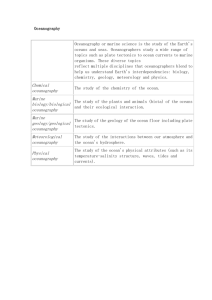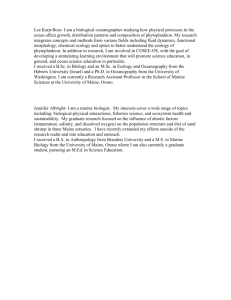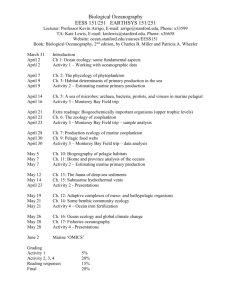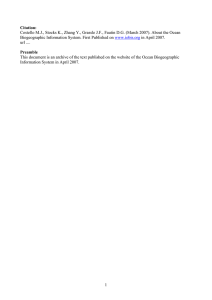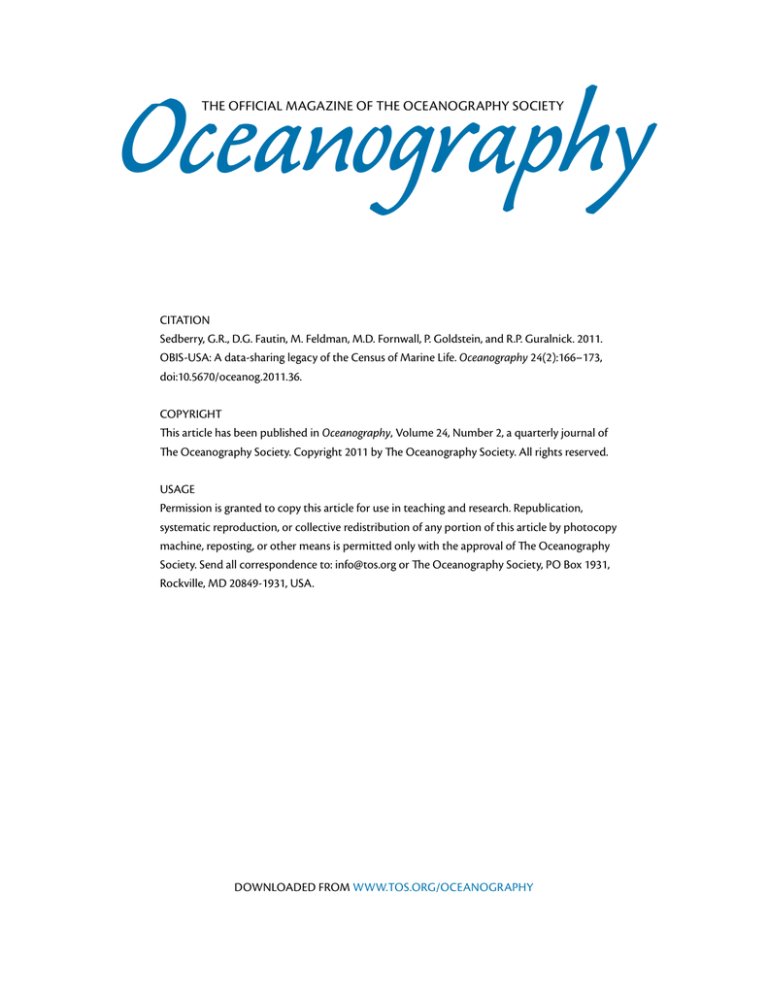
Oceanography
The Official Magazine of the Oceanography Society
CITATION
Sedberry, G.R., D.G. Fautin, M. Feldman, M.D. Fornwall, P. Goldstein, and R.P. Guralnick. 2011.
OBIS-USA: A data-sharing legacy of the Census of Marine Life. Oceanography 24(2):166–173,
doi:10.5670/oceanog.2011.36.
COPYRIGHT
This article has been published in Oceanography, Volume 24, Number 2, a quarterly journal of
The Oceanography Society. Copyright 2011 by The Oceanography Society. All rights reserved.
USAGE
Permission is granted to copy this article for use in teaching and research. Republication,
systematic reproduction, or collective redistribution of any portion of this article by photocopy
machine, reposting, or other means is permitted only with the approval of The Oceanography
Society. Send all correspondence to: info@tos.org or The Oceanography Society, PO Box 1931,
Rockville, MD 20849-1931, USA.
downloaded from www.tos.org/oceanography
R e g u l a r I s s u e F e at u r e
B y G e or g e R . S e db e rr y , D a p h n e G . F a u t in ,
M ic h a e l F e l dm a n , M a r k D . F ornw a l l ,
OBIS-USA
P h i l i p Go l d s t e in , a nd R ob e r t P. G u r a l nic k
A Data-Sharing Legacy of
the Census of Marine Life
A blackbelly rosefish, Helicolenus
dactylopterus (Delaroche, 1809),
photographed using a remotely operated vehicle at a depth of 197 m off
the coast of South Carolina (32°43.8'N,
78°05.5'W). Figure 1 shows the distribution of blackbelly rosefish, as determined from fishery-monitoring trawl
surveys. Photo credit: NOAA
166
Oceanography
| Vol.24, No.2
Abstr ac t. The United States Geological Survey’s Biological Informatics Program
hosts OBIS-USA, the US node of the Ocean Biogeographic Information System
(OBIS). OBIS-USA gathers, coordinates, applies standard formats to, and makes
widely available data on biological collections in marine waters of the United States
and other areas where US investigators have collected data and, in some instances,
specimens. OBIS-USA delivers its data to OBIS international, which then delivers its
data to the Global Biodiversity Information Facility (GBIF) and other Web portals for
marine biodiversity data. OBIS-USA currently has 145 data sets from 36 participants,
representing over 6.5 million occurrence records of over 83,000 taxa from more than
888,000 locations. OBIS-USA, a legacy of the decade-long (2001–2010) international
collaborative Census of Marine Life enterprise, continues to add data, including
those from ongoing Census projects. Among the many challenges in creating OBIS,
including OBIS-USA, were developing a community of trust and shared value
among data providers, and demonstrating to providers the value of making their data
accessible to others. Challenges also posed by the diversity of data sets relevant to
marine biodiversity stored on thousands of computers, in a variety of formats, not all
widely accessible, have been met in OBIS-USA by implementing a uniform standard
and publishing platform that is easily accessible to a broad range of users.
Introduc tion
OBIS-USA (http://obisusa.nbii.gov)
is the United States node of the Ocean
Biogeographic Information System
(OBIS; http://www.iobis.org). Established
in 2000 as a project to house data
collected by the Census of Marine Life
(hereafter called Census; http://www.
coml.org), OBIS is an online database that amalgamates and integrates
specimen-level data concerning the
distribution of marine life throughout
the world (Grassle, 2000). It comprises a
centralized coordinating office and many
regional and thematic nodes (http://
www.iobis.org/obis/regional-nodes). It
was planned from the outset that OBIS
would persist as a legacy of the Census
(Yarincik and O’Dor, 2005). As of the end
of 2010 and the conclusion of the Census
enterprise, OBIS served 30.3 million
occurrence records for 120,000 species
from 898 data sets (http://www.iobis.org/
node/307), which it delivers to the Global
Biodiversity Information Facility (GBIF),
an open-access database of terrestrial
and aquatic biodiversity (http://www.
gbif.org), founded about the same time
as OBIS. OBIS provides data and other
support to partnering Web portals
for marine biodiversity data, such as
the World Register of Marine Species
(WoRMS; http://www.marinespecies.
org/about.php) and the Encyclopedia of
Life (EOL; http://www.eol.org/content/
partners?page=4). The community-based
approach used by OBIS is similar to that
employed subsequently by the vertebrate
database VertNet (http://vertnet.org/
index.php) and its component networks
that amalgamate museum collection data,
but OBIS includes many marine databases in addition to those associated with
natural history museum collections.
Recognizing the advantages of
a decentralized structure for both
acquiring and delivering data (Fornwall,
2000), regional, national, and thematic
OBIS nodes were established to aid
in finding and gathering data, as well
as for communication and coordination. Individual node managers are
responsible for building relationships
with institutions and individuals in the
geographical or thematic purview of that
node. An individually built access portal
allows each node to offer a data interface
to meet its community’s needs, including
use of appropriate language. Other
advantages of a decentralized structure include enhancing speed of data
delivery and providing financial stability
for the enterprise.
OBIS-USA is part of the United
States Geological Survey’s Biological
Informatics Program, which provides
access to information about the nation’s
living resources, a critical national asset,
according to the National Research
Council (NRC). NRC recognized
in A Biological Survey for the Nation
(National Research Council, 1993) that
much of the considerable amount known
about living resources in the United
States was not readily accessible; state
and local governments, educational and
nongovernmental organizations, and the
private sector held a significant portion of
the data because the federal government
had not collected it. The report urged the
federal government to play a lead role
in promoting the sharing of the data to
support natural resources management.
Since its beginning in 2005,
OBIS-USA has become the major
Oceanography
| June 2011
167
provider of US marine data to OBIS.
As of January 2011, OBIS-USA served
data from 145 data sets contributed
by 36 participants, representing over
6.5 million occurrence records of
more than 83,000 taxa from over
888,000 locations. Data continue
to be added, including those from
ongoing Census projects.
In this article, we review challenges
articulated by some of the original OBIS
participants, then describe the development approach taken by OBIS-USA, and
consider future challenges. This review is
less to enumerate the accomplishments
of OBIS-USA than to impart lessons
learned about the importance of sharing
data across agencies and projects, and
how to bridge community needs. In
particular, we focus on the value of
encouraging community acceptance of
data standards that are sufficiently flexible and extensible to capture the needs
of data producers and consumers as
their needs change. For consumers, we
focus on the value of summary views
of data and metadata within and across
shared, interoperable data sets to allow
quick data discovery, enhancement, and
use; for providers, we focus on what
OBIS-USA can provide to enhance
quality of the data and metadata and
make those enhanced data more easily
discoverable and interoperable.
Challenge s
In 2000, Oceanography published a
special issue (Volume 13, Number 3)
entitled Ocean Biogeographic Information
System that provided a glimpse into the
state of marine biodiversity informatics
at the turn of the twenty-first century.
In the lead paper, Grassle (2000) put
forth the vision for OBIS as an online,
user-friendly system for absorbing,
integrating, and assessing data about
marine organisms. Authors of successive papers discussed some ongoing
marine biological data efforts and the
challenges for technological capability,
standards development (including
taxonomy and geography), data quality,
and interoperability of various forms of
data. Many authors recognized that a
critical step to resolving these challenges
was centered on improved and increased
engagement of the community of data
users and providers.
Sociological challenges can be more
problematic than technical ones for those
who develop distributed electronic data
systems such as OBIS and OBIS-USA.
Indeed, Grassle (2000, p. 7) concluded:
“The biggest challenge is for the various
stakeholders worldwide in marine
biological data to learn quickly to work
together.” A potential participant may
be reluctant to share data, fearing they
will be published before the scientist
George R. Sedberry (george.sedberry@noaa.gov) is Superintendent, Gray’s Reef National
Marine Sanctuary, National Oceanic and Atmospheric Administration, Savannah, GA,
USA. Daphne G. Fautin is Professor, Department of Ecology and Evolutionary Biology,
University of Kansas, Lawrence, KS, USA. Michael Feldman is Program Manager, Census of
Marine Life, Consortium for Ocean Leadership, Washington, DC, USA. Mark D. Fornwall
is Senior Advisor, Biological Informatics Program, United States Geological Survey, Kahului,
HI, USA. Philip Goldstein is Informatics Manager, University of Colorado at Boulder,
Boulder, CO, USA. Robert P. Guralnick is Curator of Invertebrate Zoology, University of
Colorado Museum of Natural History, Boulder, CO, USA.
168
Oceanography
| Vol.24, No.2
who gathered them can do so, or that the
data will be misused or misinterpreted,
perhaps applied in a context other than
that for which they were collected, or
subjected to exposure of gaps in coverage
or quality. Another source of reluctance
to participate is the effort involved in
creating appropriate metadata and
configuring data to meet the standards or
structure of the distributed system. The
OBIS-USA process, elaborated below in
Solutions and Process, promotes working
closely with those who may be initially
skeptical about centralizing data for
access in order to change such perceptions by showing that an open system
promotes maximal return on investment
for the high initial costs of collecting and
codifying the data.
OBIS-USA obtains data from
providers who have amassed the data for
a variety of purposes, which creates a set
of data management and standardization
challenges to be met. For example, some
of the extensive biological data from
surveys, such as those for fisheries monitoring, are obtained by visual census or
through catches discarded at sea once
standard information is recorded. Such
data may contain taxonomic errors
because of the unfamiliarity of fishery
surveyors with current literature, or
because of taxonomic changes published
since the surveys were conducted
(e.g., Collette and Vecchione, 1995).
Because museum data are based on
voucher specimens (which may include
specimens from surveys), an identification can be corrected, sex can be determined, and (for many) a DNA sequence
can be obtained long after the specimen
is collected. However, many museum
specimens lack details contained in
survey data, such as sampling methods,
abundance, and precise collection
locality. Integrating data from diverse
sources requires in-depth understanding
of the complex differences among data
sets and broadening metadata standards to include both the simplistic
and the very rich data delivered by
providers. Understanding and managing
for these differences is essential for
creating an integrated, useful, and welldefined data system.
A related scientific challenge,
discussed by several authors in the 2000
Oceanography volume, is taxonomic and
nomenclature change and uncertainty.
OBIS-USA receives data at various levels
of taxonomic detail. Some participants
identify a full taxonomic hierarchy;
some provide only scientific name. Data
collectors and providers rely on many
taxonomic authorities and methods to
make identifications, but information on
how the identification was made is often
not included with the specimen record.
Despite the best efforts of the data
providers, taxonomic detail may contain
what appear to be errors, such as multiple
spellings for a taxon, or using out-of-date
nomenclature. These errors may decrease
the value and usefulness of the data
sets. OBIS-USA staff screens data upon
receipt, and alerts participants to possible
taxonomic issues. In most cases, this
review does not result in any immediate
change to data by the participant, but it
may generate valuable follow-up tasks for
the future that participants can prioritize
and conduct as suits them. OBIS-USA
is currently developing approaches to
check taxonomic names as provided
by participants against the Integrated
Taxonomic Information System (ITIS;
http://itis.gov), as a reference. ITIS is a
partnership of agencies and organizations
such as the Catalogue of Life (COL;
http://www.catalogueoflife.org) from
the United States, Canada, and Mexico,
with experts from around the world, that
has created a database of scientific and
common names of biota of interest to
North America. ITIS, like OBIS-USA,
is part of the US National Biological
Information Infrastructure (http://www.
nbii.gov) and an associate member of
GBIF. OBIS-USA staff consults with
these additional biodiversity databases
for taxonomic consistency. The goal of
this check is not to change original data,
but to determine if cross-referencing to
ITIS can enhance search and usability of
data in OBIS-USA.
A final challenge, one that is critical
to engaging users, is timely response to
queries. In the early stages of OBIS, the
system was operationally distributed, so
each query received was sent to all data
providers. As the number of providers
increased, response time slowed markedly. Additionally, if one provider did
not respond, the entire query failed.
Even for successful queries, the extent
of the network successfully accessed
was unknowable, and metrics of data
download and use could not be tracked
(Constable et al., 2010).
Solutions and Proce ss
OBIS-USA has overcome technical and
sociological challenges to develop a
functioning ocean biogeographic datasharing community that engages a wide
range of participants. Collaboration is
encouraged through clear explanations
to potential data providers and users
of the many benefits of participation in
the OBIS-USA network. Recruitment of
participants who are new to the concept
of data sharing has required a proactive
process that ensures members of the
community are included in each step of
developing OBIS-USA. Careful listening
by the staff allows participants’ needs to
be addressed by adapting protocols to
handle issues such as those concerning
data standardization.
Foremost among the numerous benefits to both users and providers of integrated data is identification of errors and
areas of concern; this evaluation often
occurs through the opportunity to review
data with a set of fresh eyes. Formatting
procedures help to spot, for example,
geographic outliers and taxonomic
inconsistencies. Inconsistencies are
reported to the data provider, who can
then examine the data set for possible
errors. A report of taxonomic inconsistency, for example, seldom results in an
immediate change, but, as time becomes
available, the participant may follow
up and subsequently provide cleaner
data sets to OBIS-USA. By engaging in
this process, participating institutions
become more aware of external data
standards and practices that might be
useful in collecting and processing data.
As trust and understanding increase
between OBIS-USA and data providers,
long-term relationships and feedback
loops develop so providers improve
their data collection and archiving practices. In turn, subsequent data transfer
to OBIS-USA becomes more efficient
and thus helps encourage additional
participation from existing and new data
providers. Tools being developed will
automate some aspects of dealing with
taxonomic and nomenclatural issues,
thereby eliminating the sometimessignificant costs of human intervention
to alter records. Better documentation
of how data are systematically collected
Oceanography
| June 2011
169
using standard vocabularies has minimized taxonomic problems: common
names used in commercial trade represent a standard taxonomy that is both
highly reproducible and easily translatable to a scientific name.
Engagement with data providers and
users fulfills two critical elements of
OBIS-USA: creating metadata to help
users discover the data and assess its
suitability for use, and assisting providers
in making available to the public data
that are of the highest quality possible.
Serving high-quality data can involve
costs (including effort) to the provider,
although these costs are often overestimated. OBIS-USA offers a user-friendly
interface, and devotes significant staff
time to assisting providers with metadata
preparation and mapping data to the
OBIS data schema (http://www.iobis.
org/data/schema-and-metadata) so that
data are fully captured while minimizing
the burden on providers. Most providers
are willing to improve data. The result is
community access to a set of data that is
spatially, taxonomically, and temporally
as comprehensive and error-free as
possible. Data gaps revealed through the
collaboration provide a basis for future
research. In addition, participants join a
community of skilled data collectors and
processors, which provides an opportunity for sharing of skills and knowledge.
Recognizing the primary importance
of licensing, data attribution, and citation, OBIS-USA works with its providers
to establish proper intellectual property
practices. Attributions and data-use
constraints are included for each data
set by the contributor, and these are
incorporated into metadata that are
compliant with Federal Geographic
Data Committee standards. A user
170
Oceanography
| Vol.24, No.2
who requests data agrees to constraints
and proper citation requirements upon
clicking the download button. OBIS-USA
will not make public any participant’s
data until these elements of metadata are
in place; this is the most rigid requirement OBIS-USA places on metadata.
With regard to use and citation agreements for data delivered via Web services
(see below), OBIS-USA includes the
participant’s identification, citation, and
use limitations in every record returned
by the service. OBIS-USA is evaluating
whether such citation information is
excessive, but initial results suggest that
providing it is prudent.
Using OBIS-USA
The OBIS-USA Web site allows users
to search and acquire data sets or
individual records of interest. Current
access tools are effective, but OBIS-USA
continues to introduce new search tools
that accomplish much more: some are
already available as beta test on the
public site. Through these search tools,
an OBIS-USA user can select data sets
by spatial criteria and search on fields
such as scientific name (Figure 1).
OBIS-USA companion tools summarize
characteristics of every data set, sorted
by the attributes, quantity, and quality of
the contents, down to individual fields.
Users may review quality by using applications that provide presentations of
taxonomic depth and duplication of data
for each data set. Tools allow for some
simple analyses of the data concerning
spatial extent (in three dimensions)
and taxonomic classification. While not
eliminating problems concerned with
taxonomic and geospatial precision,
this approach allows a user to assess
each data set or record for its fitness of
use for his/her needs.
A user can evaluate and download
records that lie within geographical
boundaries drawn using a familiar
Internet mapping interface. A quick
analysis and mapping option informs the
user about the number of records in that
geographic area and the data sets from
which they come (Figure 2). The user
will have the option of downloading the
entire selection or individual data sets.
More in-depth analysis, which can take a
few seconds or a few minutes depending
on the scope of the search, enables the
user to see and download data within
the geographic bounding box by data set,
date, depth, and taxon (full taxon list, or
the 25 most frequent, or predominant
higher-taxon groups).
When a user obtains results of searches
by taxon or geographic area, sorted by
the data sets in which records are found,
s/he has three options to download and/
or explore the data further. The user
can (1) download all the records that
match search criteria for that data set;
(2) view metadata that describe purpose,
methods, and other details about the
data set relevant to both discovery and
use (Figure 2); and (3) refer to additional
Web-based resources or publications
related to the OBIS-USA representation
of the data set, including the collection of original research data products
(e.g., reports, publications), and hydrographic measurements (e.g., depth,
temperature, salinity), if available. The
third option is still under development.
Enthusiasm for this function by participants, some of whom have offered to
provide such links for their own related
resources, has helped make tangible the
community benefit that is the goal of
such an offering.
It is critical to the usability of
OBIS-USA that all the features for
downloading data are enabled for
Web services. The primary objective of Web service access is to allow
machine-to-machine access so a user
can automate mapping or analysis, and
create searches by criteria other than
those available through the OBIS-USA
site. Web services also provide a means
of integrating biological data served by
OBIS-USA with hydrographic, meteorological, human-use, and other such
data. OBIS-USA makes it possible for
biological information and multiple
other data types (e.g., temperature or
salinity) that share spatial and temporal
data (e.g., coordinates or date) to be
queried simultaneously, an essential step
in coastal and marine spatial planning.
Indeed, previous investigations using
the OBIS database show that sea surface
temperature is an important environmental predictor of marine biodiversity
(Tittensor et al., 2010). This approach
needs further investigation on a finer
scale, and in relation to other environmental variables as those data become
available at OBIS-USA.
The initial Web service implementation for OBIS-USA uses the
National Oceanic and Atmospheric
Administration (NOAA) Environmental
Research Division’s Data Access Program
(ERDDAP) Web service facility (http://
coastwatch.pfeg.noaa.gov/erddap/
index.html). The OBIS-USA ERDDAP
services are at http://obis-usa.colorado.
edu/erddap/index.html. ERDDAP
allows access to multiple data types
and their integration using standard
and commonly used formats, including
(but not limited to) Network Common
Data Form (NetCDF), MATLAB, and
Keyhole Markup Language (KML). Once
in a common format, different types of
data can interact in integrated models
and applications.
The Future of OBIS-USA
OBIS-USA has a thriving and growing
data-sharing community that is heterogeneous in terms of sources, including
natural history museums, fisheries
agencies, ocean data centers, and the
private sector. It thus represents a
unique resource for those interested
in ocean biodiversity and natural
resource management.
The challenges related to data sharing
and quality are slowly being addressed,
but much remains be done. Two key
areas that need continued attention
are integrating geographic and environmental data with the biological
data more fully, and developing more
Figure 1. A screen capture from a species
query for blackbelly rosefish (Helicolenus
dactylopterus) in the OBIS-USA database. For this particular map, fishery
trawl-survey data sets from the east
coast of North America (Northeast
Fisheries Science Center and Marine
Resources Monitoring, Assessment,
and Prediction surveys) were selected.
This image was obtained by accessing
the OBIS-USA Web site (http://obisusa.
nbii.gov), then by clicking Atlas, then
selecting the MARMAP Yankee Trawl
and NEFSC Bottom Trawl data sets, then
selecting the Scientific Name Helicolenus
dactylopterus from the drop-down list,
and then clicking Map.
Oceanography
| June 2011
171
Figure 2. Screen captures from further
exploration of data contained in a
geographic area searched by clicking
Geographic Search at http://obisusa.
nbii.gov, and then conducting a
Bounding Box query. The query
located 140,294 species distribution records in 17 data sets. The
inset (lower right, which opens as a
separate window upon clicking View
BPBM Metadata on the Bounding Box
window) illustrates
an exploration of
the metadata that
describe purpose,
methods, and other
details about the
data set. In this case,
metadata are shown
for 1598 records from
collections that were
made in the area of
the bounding box
drawn around the
main Hawaiian Islands,
and that are now
housed at the Bernice
P. Bishop Museum
(BPBM).
flexible metadata standards that meet
community needs.
Ocean scientists commonly express
the desire to integrate knowledge of
organism distribution and demography
with oceanographic and atmospheric
data from multiple platforms and
sources. Some fisheries surveys record
environmental parameters such as
temperature, salinity, dissolved oxygen,
and pH with specimens sampled. But
more commonly, environmental data
are recorded separately from organism
localities, so national or global products documenting physical properties over time must be overlain on
records of organism occurrences to
understand the influence of physical
factors and how they vary in time and
172
Oceanography
| Vol.24, No.2
space. Easily linking an ever-growing
summary of environmental layers to
organism occurrence records, such as
are assembled by OBIS-USA, remains
a challenge. Ocean environmental data
layer repositories are currently being
developed by several university and
agency groups (e.g., Ghent University,
http://www.oracle.ugent.be; National
Center for Ecological Analysis and
Synthesis working group, www.nceas.
ucsb.edu/projects/12504; Pacific Marine
Environmental Laboratory, http://
www.pmel.noaa.gov/datalinks.html).
The value of environmental variables
obtained from ocean observing networks
and other environmental monitoring
efforts must be compared with those
measurements obtained synoptically
with organism collections. When those
environmental values agree within
desired tolerances, a major objective of
an ocean biogeographic information
system will have been achieved.
Another challenge is to include
abundance data, which will inform
population and community ecology, and
serve natural resources management
and conservation. The OBIS schema
can accommodate simple measures
of abundance, but is currently insufficient for the more detailed knowledge
captured by many fisheries monitoring
surveys. OBIS-USA is collaborating
with the NOAA Integrated Ocean
Observing System, the NOAA Pacific
Island Fisheries Science Center, and the
University of Hawaii to lead the way in
creating interoperability between diverse
biodiversity and ecological data.
Conclusion
The 10-year Census of Marine Life just
ended. New species were discovered
and vast areas of the sea were explored,
adding to knowledge of global patterns
of marine biodiversity (Costello
et al., 2010). As initially envisioned in
Oceanography (Volume 13, Number 3)
in 2000, OBIS and its nodes (including
OBIS-USA) not only served as repositories of data from this project but also
constitute the commencement of the
online atlas of marine organisms.
OBIS-USA represents a national-scale
effort to provide an ever-growing knowledge base that links related resources. In
so doing, OBIS-USA both preserves and
provides access to heretofore difficultto-access data; it makes them interoperable through careful adherence to
metadata standards and interfaces. This
readily available compendium of marine
biodiversity allows some of society’s
most complex problems to begin to be
addressed by serving data in accessible
formats needed by managers and policymakers (e.g., Bjorndal et al., 2011) that
can be used with decision-support tools
(e.g., in coastal and marine spatial planning). OBIS-USA will enhance research,
as well, by pointing to gaps in knowledge, including taxa and geographical
regions in need of additional exploration; such efforts are already underway
using OBIS data (e.g., Mora et al., 2008).
By mobilizing data from institutions
with diverse cultures and histories,
OBIS-USA has begun to meet the challenge of open science and open data
across a broad participant spectrum.
A community and culture of data
sharing, initially envisioned over 10 years
ago, has been achieved for a common
good and will support shared missions
in monitoring and assessing ocean
biological resources.
Acknowledgements
This summary of OBIS-USA and associated programs evolved from, and was
improved by, discussions with many
participants in the Census of Marine Life
and OBIS. In particular, we thank past
and present members of the US National
Committee (USNC) for the Census.
Support for our work and the USNC
was provided by the Alfred P. Sloan
Foundation and the National Oceanic
and Atmospheric Administration’s
Office of Ocean Exploration and
Research; USNC was coordinated by
the Consortium for Ocean Leadership.
This work was also supported by the
United States Geological Survey and the
Bureau of Ocean Energy Management,
Regulation and Enforcement as
well as our respective agencies
and universities.
Fornwall, M.D. 2000. Planning for OBIS:
Examining relationships with existing national
and international biodiversity information
systems. Oceanography 13(3):31–38. Available
online at: http://www.tos.org/oceanography/
issues/issue_archive/vol_13.html (accessed
April 19, 2011).
Grassle, J.F. 2000. The Ocean Biogeographic
Information System (OBIS): An on-line, worldwide atlas for accessing, modeling and mapping
marine biological data in a multidimensional
geographic context. Oceanography 13(3):5–7.
Available online at: http://www.tos.org/
oceanography/issues/issue_archive/vol_13.html
(accessed April 19, 2011).
Mora, C., D.P. Tittensor, and R.A. Myers. 2008.
The completeness of taxonomic inventories for
describing the global diversity and distribution
of marine fishes. Proceedings of the Royal Society
B–Biological Sciences 275:149–155.
National Research Council. 1993. A Biological
Survey for the Nation. Committee on the
Formation of the National Biological Survey,
National Academy Press, Washington, DC,
205 pp.
Tittensor, D.P., C. Mora, W. Jetz, H.K. Lotze,
D. Ricard, E. Vanden Berghe, and B. Worm.
2010. Global patterns and predictors of marine
biodiversity across taxa. Nature 466:1,098–
1,103, doi:10.1038/nature09329.
Yarincik, K., and R. O’Dor. 2005. The Census of
Marine Life: Goals, scope and strategy. Scientia
Marina (Barcelona) 69(suppl. 1):201–208.
Reference s
Bjorndal, K.A., B.W. Bowen, M. Chaloupka,
L.B. Crowder, S.S. Heppell, C.M. Jones,
M.E. Lutcavage, D. Policansky, A.R. Solow,
and B.E. Witherington. 2011. Better science
needed for restoration in the Gulf of Mexico.
Science 331(6017):537–538.
Collette, B.B., and M. Vecchione. 1995. Interactions
between fisheries and systematics. Fisheries
20(1):20–25.
Constable, H., R. Guralnick, J. Wieczorek,
C. Spencer, A.T. Peterson, and the VertNet
Steering Committee. 2010. VertNet: A new
model for biodiversity data sharing. PloS
Biology 8(2):e1000309, doi:10.1371/journal.
pbio.1000309.
Costello, M.J., M. Coll, R. Danovaro, P. Halpin,
H. Ojaveer, and P. Miloslavich. 2010. A census
of marine biodiversity knowledge, resources,
and future challenges. PloS ONE 5(8):e12110,
doi:10.1371/journal.pone.0012110.
Oceanography
| June 2011
173

